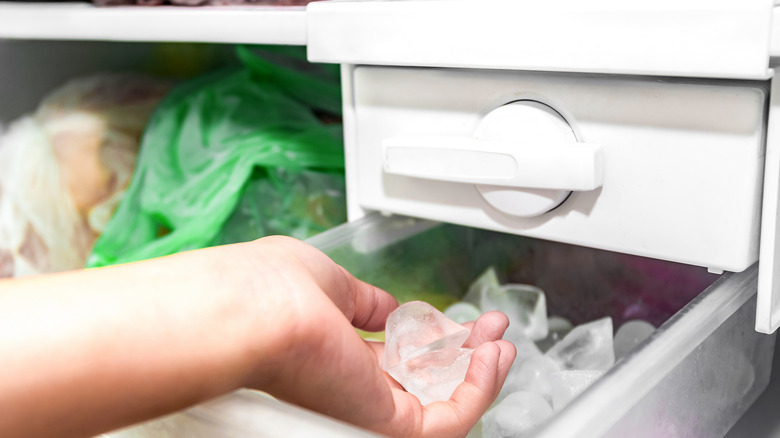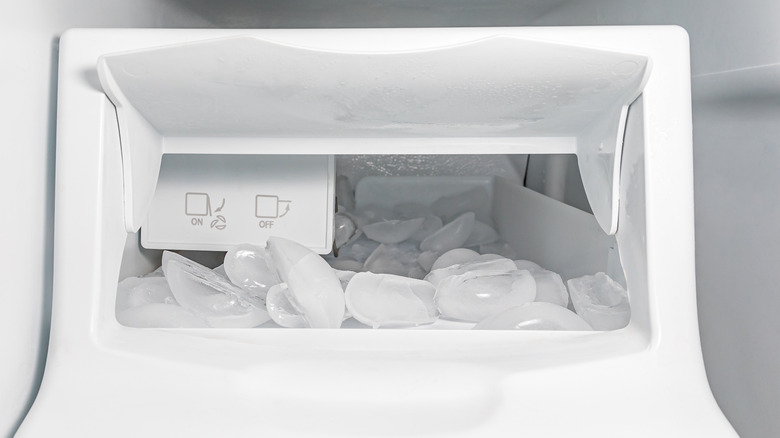How Does A Fridge's Icemaker Work? A Look At The Tech Behind It All
In the first half of the 19th century, a Bostonian named Frederic Tudor started a business of harvesting ice from frozen natural reservoirs like ponds and storing them in ice houses. It was a lucrative business, expanding from the US and all the way to Hong Kong and Brazil. By the time Tudor departed the mortal plane, his ice business had pulled him a fortune worth around $200 million. Today, you can buy a countertop icemaker machine for $50 on Amazon, and a fancy refrigerator with a built-in icemaker for under a thousand dollars.
It's no longer a luxury, but more of a kitchen necessity. In refrigerators that offer a native icemaker capability, they come with a dedicated compartment that is constantly kept at a lower temperature and cycled periodically. The first three stages — filling the water, cooling, and freezing — work like your average freezer compartment. It's the additional fourth step of de-icing with dedicated hardware fitted inside the icemaker compartment that sets them apart.
After water is filled through a valve in the mold, It starts cooling while a thermostat keeps an eye on the temperature. Once the water solidifies after reaching a specific temperature, the cooling process is stopped and the harvesting system kicks into action. In icemaker units where the mold is made out of metallic parts (such as aluminum), a heating coil underneath warms up the ice mold, releasing the cubes into a tray or bucket. Only when it's emptied does the next ice-making cycle begins.
Looking inside ice, through science
The functioning theory behind ice makers is not too different. The most interesting element, however, is how they serve the ice after freezing the water that is fed to the mold. In lower-cost or small-format refrigerators, the mold tray is usually made out of pliable plastic that can be twisted by applying a small amount of rotating force at either end.
It's an entirely mechanical process, similar to the way you twist ice cube trays made out of plastic or rubber with your hands. Depending on the model you pick, some refrigerators also offer an ice checkup sensor lever to detect the amount of ice in the bucket and flip the same in order to empty it. In the higher end models, the process is automated.
According to an analysis of integrated icemakers published in the Applied Thermal Engineering (PDF) journal, the top surface and the vertical surfaces solidify first in the mold, but there is usually some variation between the inner and outer surface of the cubes. If one were to quantify it, we are looking at a variation of 10.4-degree to 17.6-degree Fahrenheit.
Scientifically, the latter is the most optimum temperature to extract the ice cubes from the mold for two key reasons. First, it reduces the time taken for solidification by 18%, and second, the amount of ice you can make per day goes up by 20%. In a nutshell, you are not only making more ice, but also saving up on the energy uptake.
What about their energy footprint?
According to the Department of Commerce's National Institute of Standards and Technology (NIST), there is a huge difference in the efficiency of energy consumed by icemaker units. It notes the most efficient models consume nearly half the energy compared to the least efficient machines. There are multiple factors that come into the picture when you're planning to buy an icemaker-equipped refrigerator based solely on its efficiency.
The extra electrical energy taken by the ice-making unit depends on the volume of ice being produced on a daily basis, the number of cycles, and even the kind of de-icing system in these icemaker compartments. If power consumption is of paramount importance, you may have to make some hard choices regarding the form factor, as well. Single-door refrigerators utilize a twist-based tray system to collect the ice cubes, while the pricier French door models use an electrically heated system.
The ice mold ejection heaters are typically turned on for one to two minutes to take out the ice cubes from the molds while being operated at a power intake range of 100-200 watts. But as mentioned above, there are too many variables regarding the operational efficiency of built-in icemakers in refrigerators. "There is no standardized point to which the test results from different units could be compared," says NIST, adding that a broad set of calculations can be applied, but nothing definitive has been adopted as an industry standard specifically covering the energy rating for icemaker units, so far.


